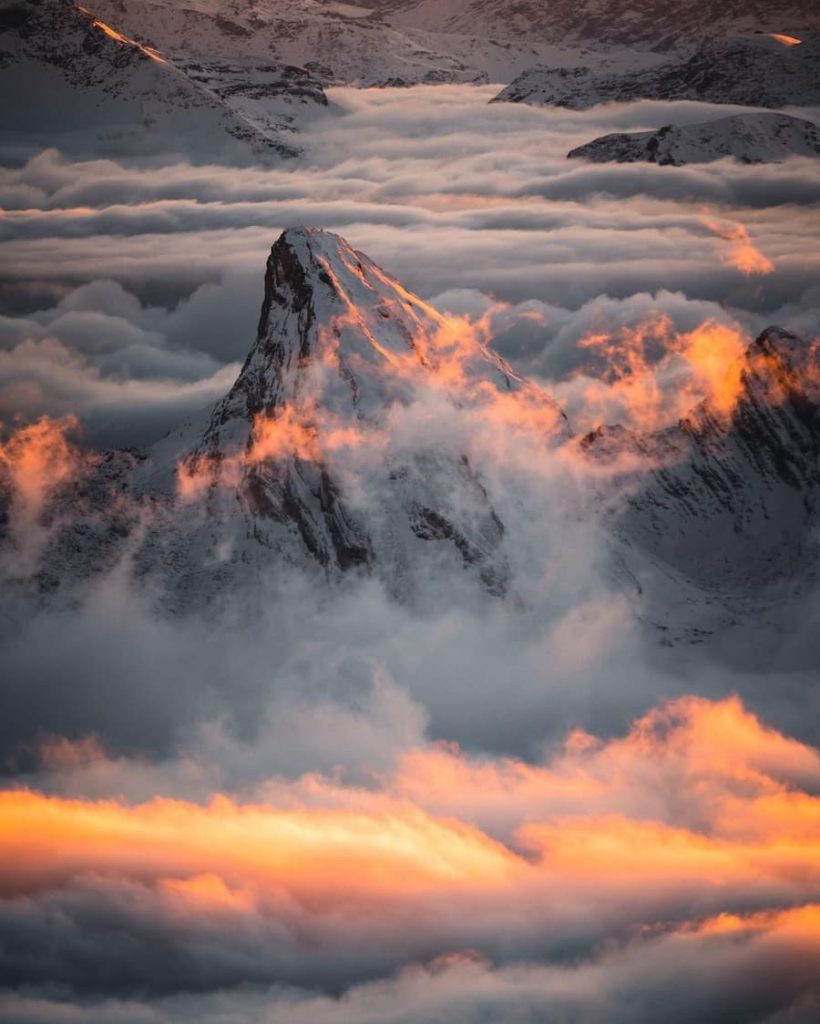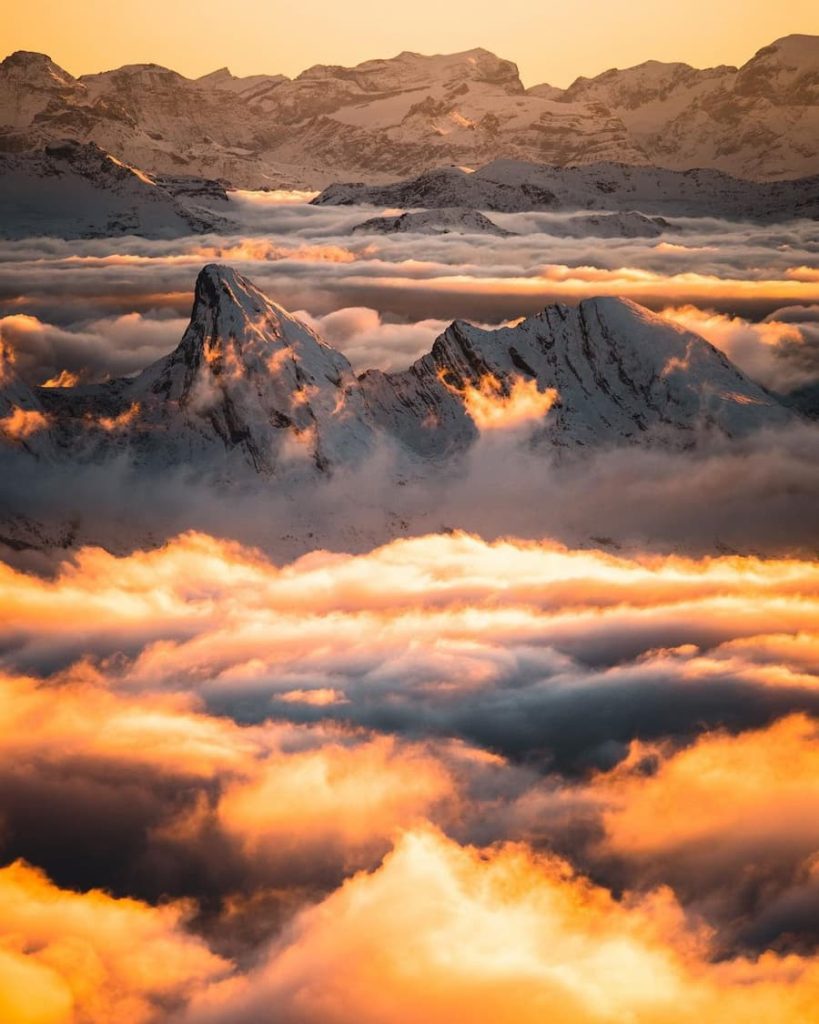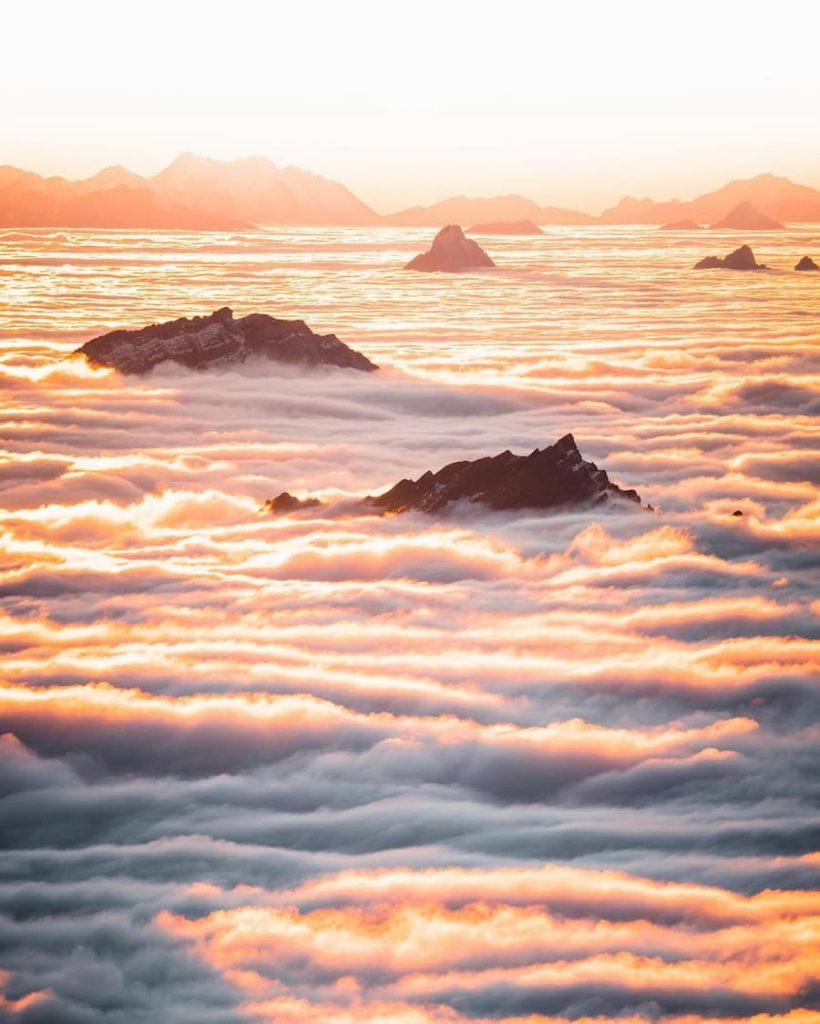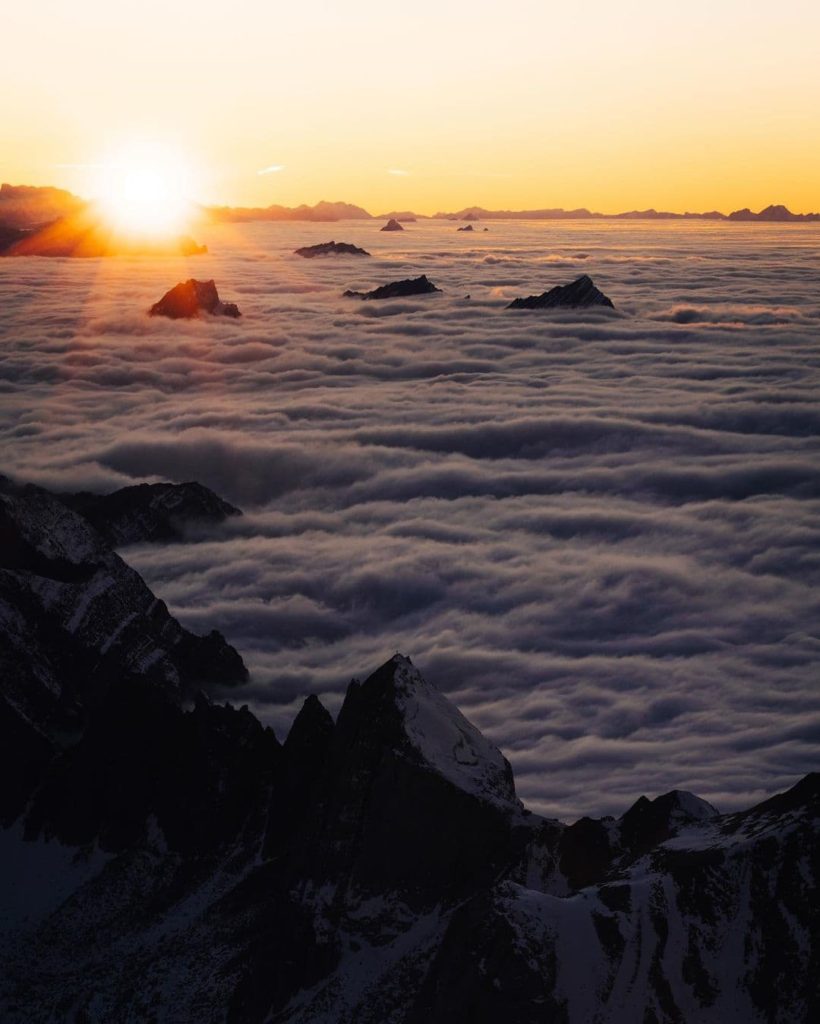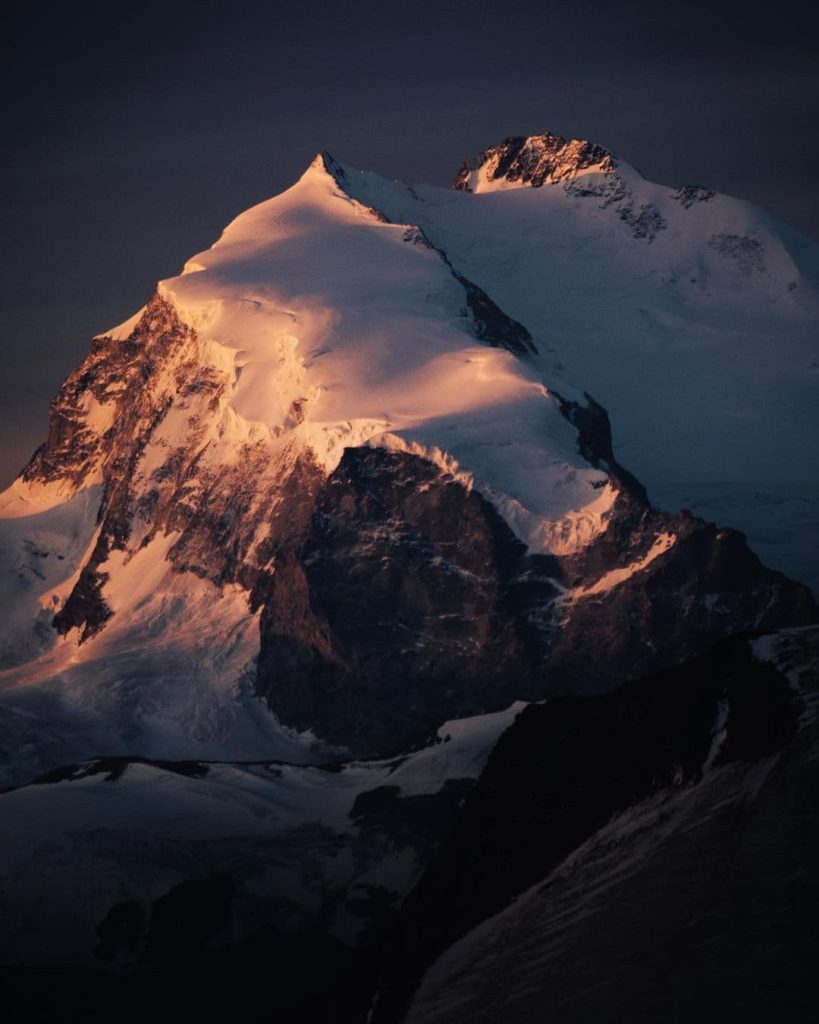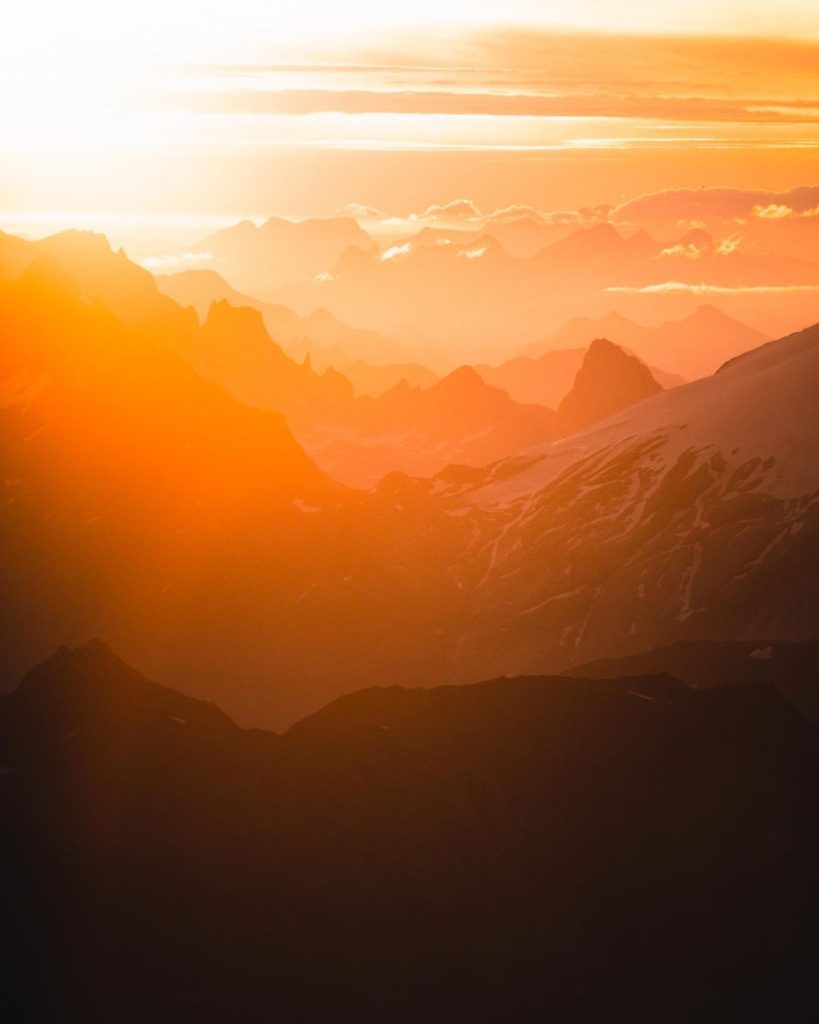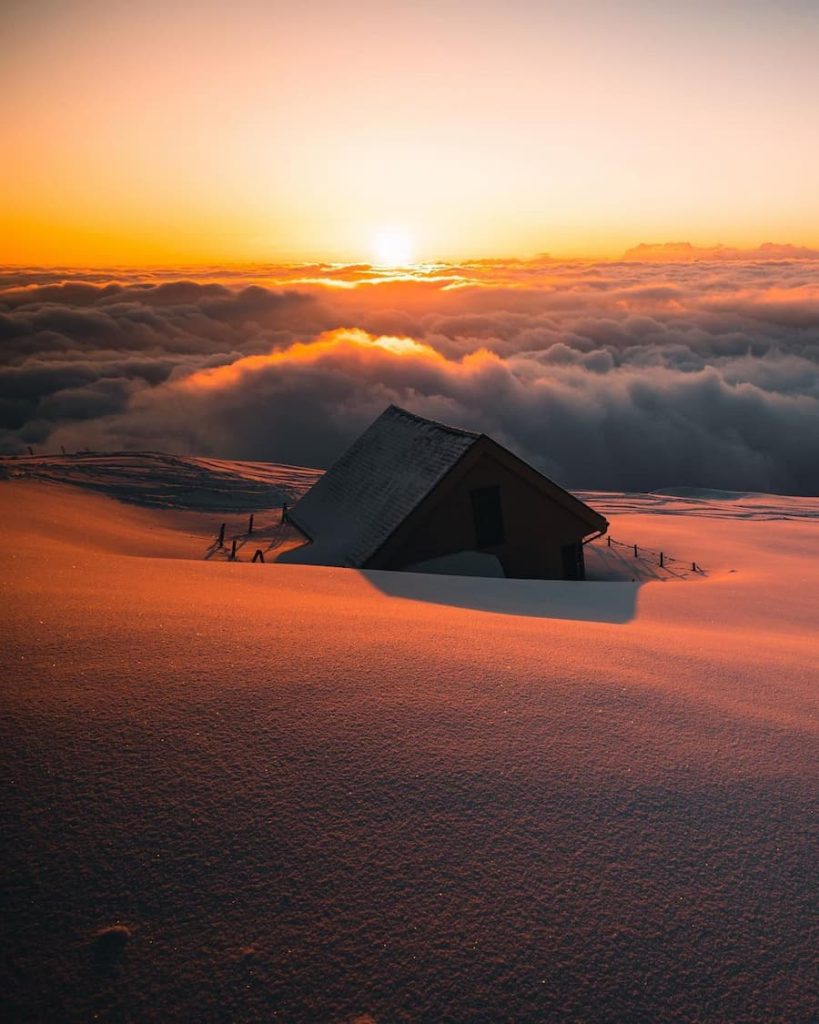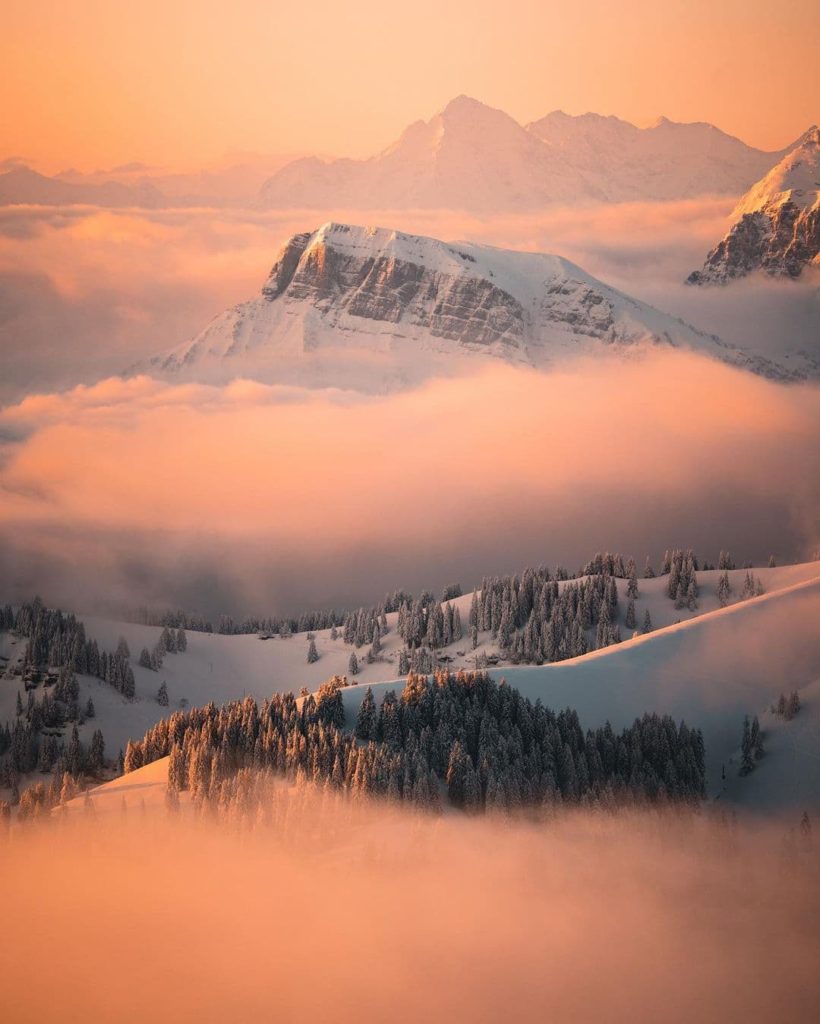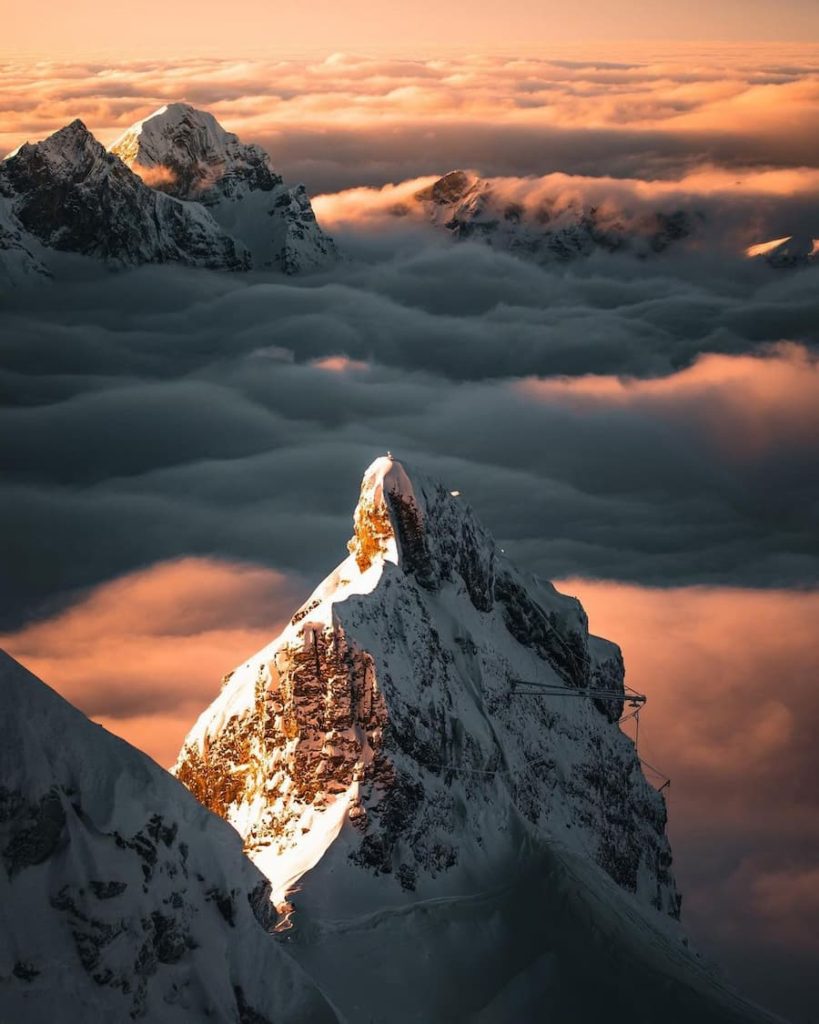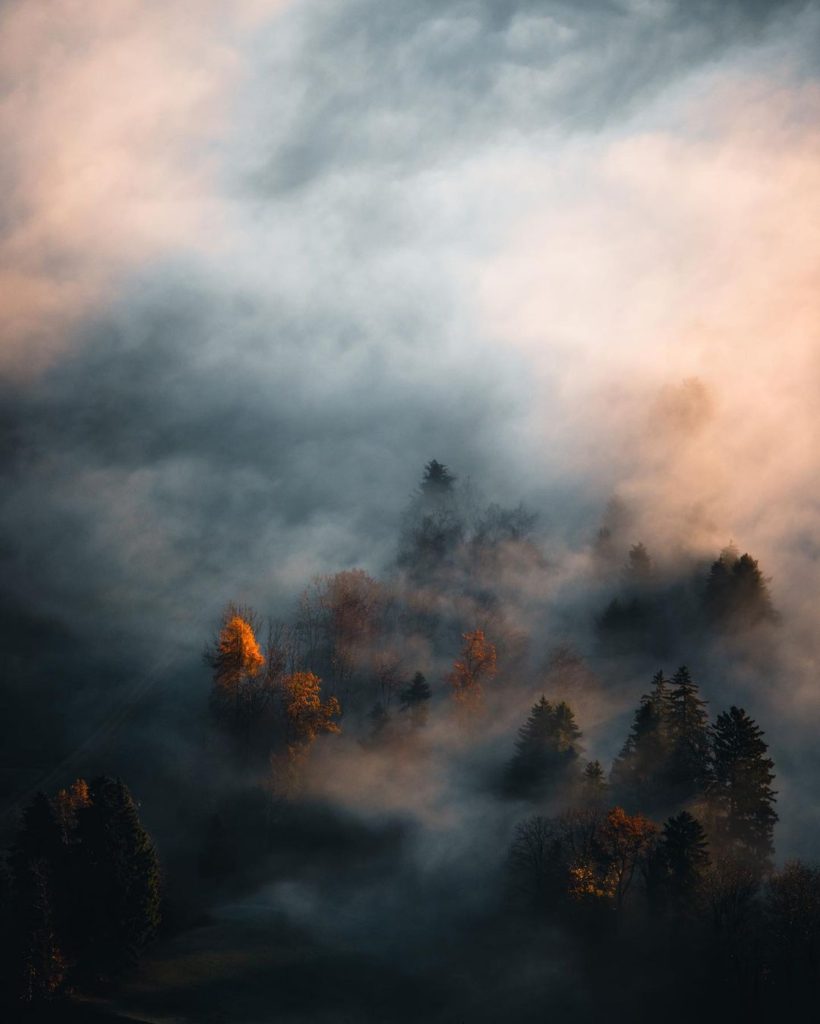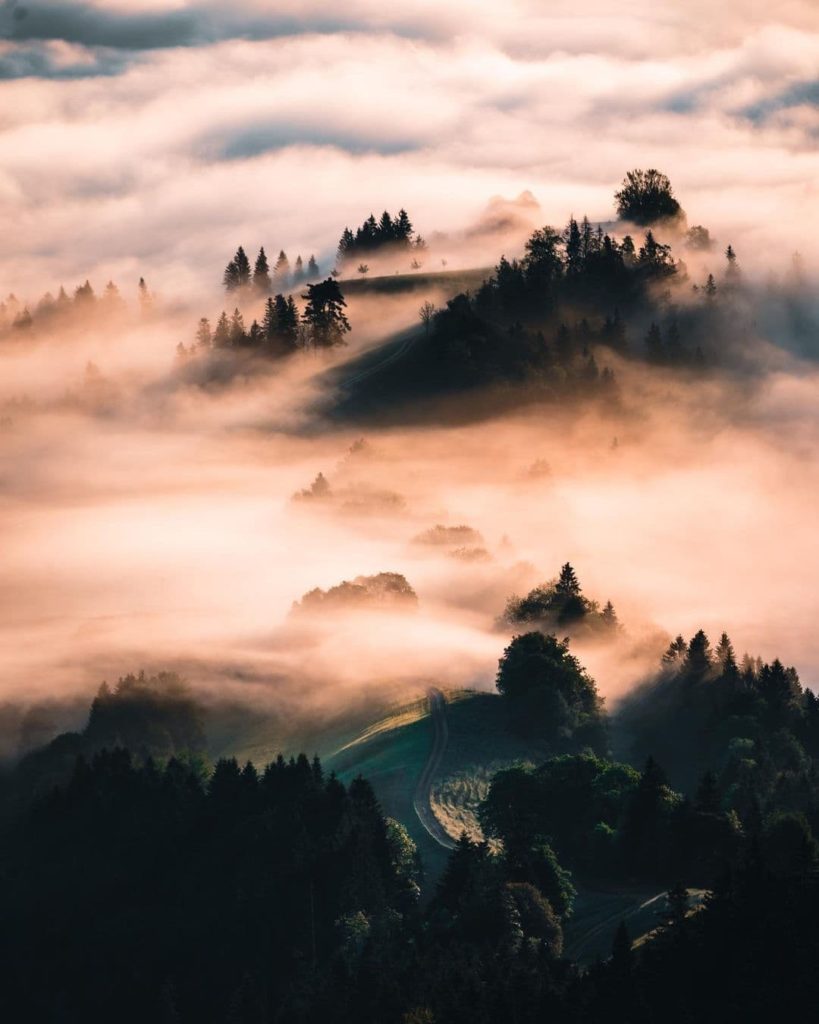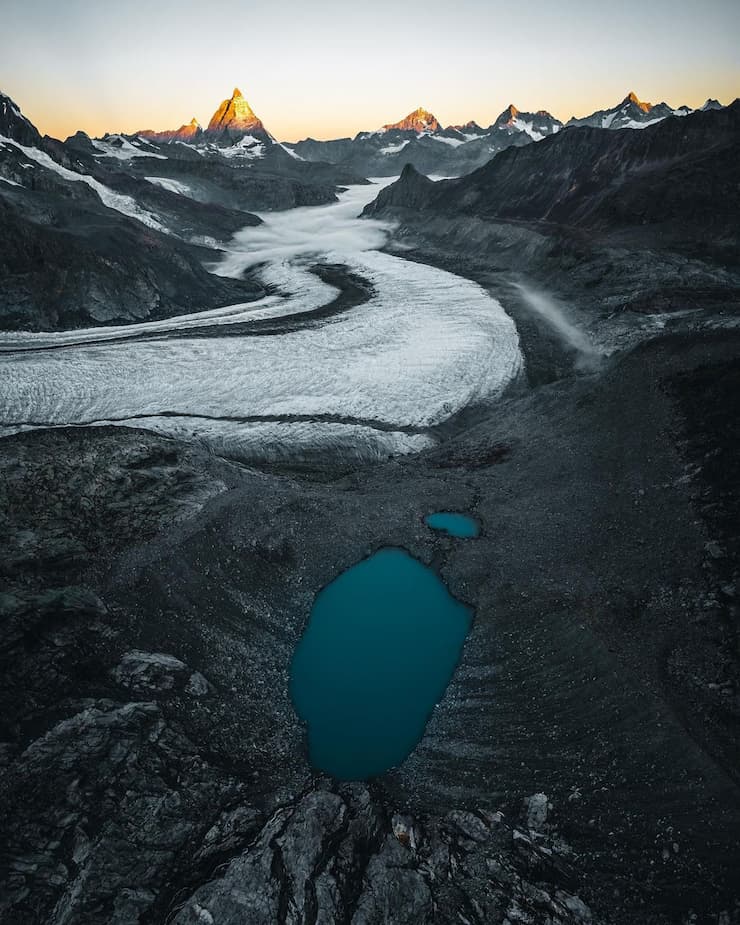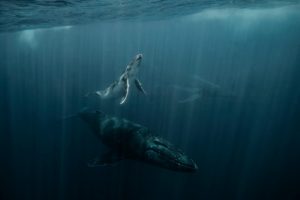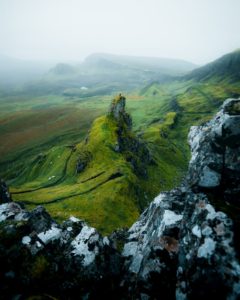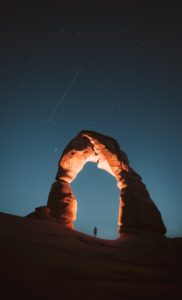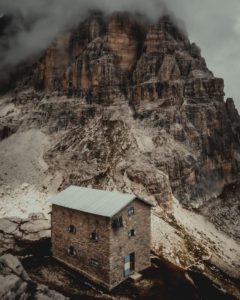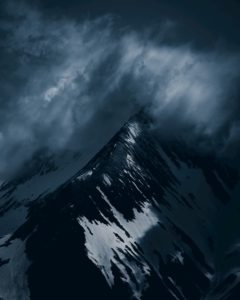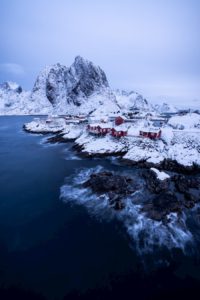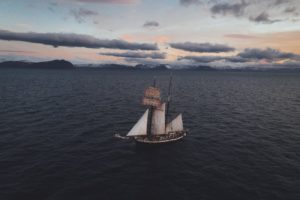
Maximilian Gierl
@maximiliangierl
Alpinist and photographer based in Switzerland
Introducing Maximillian Gierl
Maximilian is an accomplished 35 years-old alpinist, outdoor photographer, and medical doctor. Choosing the mountains, he moved to Switzerland, where he completed his education in Mountain Medicine and learned everything about climbing. Photography accompanied him on his adventures, and he soon found his niche. He mentioned: “In my case, I go to places people usually do not go. And if they go, they do not bring a camera. If you find your passion and follow it until the end, you will likely find new ways of doing things that will differentiate you from the rest. Once you are there, chances will also be higher for you to work in/on something you love.” This reflection was eye-opening and just as inspiring as getting to know about his alpinism project, climbing the 48 4000m+ mountains in Switzerland:
“When the pandemic in 2020 started, I thought about what to do and found myself super motivated to focus on the 4000m peaks that I had not climbed yet, which were 33 out of the 48 4000m peaks. During summer, things worked out very well, and by the end of 2020, there were only 21 of the 48 peaks left that I had not climbed. So, the project 21in21 was born, meaning to climb those missing 21 peaks above 4000m.”
Maximilian accomplished his goal, and in this new interview, he shared the core experiences, methods, and lessons from such a unique endeavor. So you will learn a few tips on how to become a pro alpinist starting from scratch and how to successfully combine alpinism with photography in the safest way from a technical and creative point of view. Maximilian also speaks about the specifics of photographing in the mountains and shares the tips that helped him grow as a visual creator.
In the last part of the interview, he shared tips to accelerate your learning curve and develop any skill. He also addressed how anyone can find a niche and how to make money with photography in a sustainable way. There is quite to learn from the +5,000 words Maximilian shared with us, so we hope you enjoy this interview!
Interview
Welcome, Maximilian! From Medicine to the Mountains and Photography, you are attracted by “the moments where every minute counts.” Can you tell us how these three passions got intertwined and are part of your life nowadays?
Toward the end of my studies, I considered various countries where I could work as a medical doctor and where I would be close to the sea or the mountains, such as Switzerland, Italy, Spain, and France. I decided that Switzerland could be a good fit. I was already familiar with the educational and labor system because I had spent three months working there before. So, I moved to Switzerland after my studies to get in touch with everything related to mountaineering.
Then, I studied surgery, anesthesia, and intensive unit care for two years. Working as a surgeon means spending a lot of time in the hospital, which is why I decided to switch to anesthesia. Today, I am a general practitioner working with different patients in a small town in Central Switzerland. Working as a medical doctor teaches you to live life to the fullest as no one knows what tomorrow is gonna be like. Things can change in a split second in life and the same goes for the mountains and photography, I learned later.
How did climbing and photography become a more serious aspect of your life?
Besides the fact that I was familiar with the social systems in Switzerland, I also chose this country because of the mountains. Furthermore, you can practice so many outdoor activities: climbing, trail running, skiing, kayaking, and everything at reach. Needless to say, it also offers countless photographic possibilities.
I came to a point where I was working a lot, but I didn’t want to miss sunsets at the summits. I grabbed a small camera and started running up the mountains. I can say that this was the beginning. As I shared the images I captured on these experiences, I received compliments from my friends and family. In a way, what caught their attention were the rare scenes from the mountain tops, which have not been captured or shared that often.
I also became more serious about climbing. I have always wanted to visit Nepal and at the time, I had a holiday of ten weeks because of the overtime I accumulated as a surgeon. When my relationship with my ex-partner ended, I pursued my dream and traveled to Nepal. During the first weeks, I hiked and worked in a hospital and I eventually familiarized myself with the glaciers and high alpine conditions in the Everest region.
"To experience mountaineering in such a unique location inspired me to keep learning. It is so intimidating to be surrounded by such a surreal and giant landscape."
When I came back to Switzerland, I investigated the climbing skills I would need to keep developing myself in the niche. Luckily, I found out about the education for mountain medicine and all I needed was the International Education Diploma to keep building my skills and do mountaineering more often. This course taught me safety and rescue techniques in the mountains, as well as the physical issues that can happen when being in the (high) mountains (e.g. frostbite, high altitude sickness, or pulmonary edema) and how to deal with them. I also learned to calculate risk in alpine terrain and I had avalanche training. There are many things I learned in this course that I still use – and everyone should be using – to prepare before heading out. In 2015 I was ready to climb my first 4,000-meter peak in Switzerland, and so I did.
All this time, photography accompanied me. In 2016, I decided to do photography part-time and treated it as a side business. I thought it would take me seven years to reach my initial goals and establish photography as an additional income. So initially, I set my mind to concentrate on little steps and I started doing some photography-related gigs while introducing videography into my set of skills. I also wanted to focus less on medicine, although the perfect match would be to have a job where I can combine both. In the end, medicine is not creative, and being creative is a part of me that I enjoy. It is part of who I am, and therefore it was essential for me to build it into my daily life.
What was your first camera, and what gear do you use nowadays?
When I was 12 years old, I got my first camera from Aldi, a discount supermarket. Later I bought a Canon, and in Switzerland, I purchased a 6D Mark-one. I was also using a Sony XR100. At the moment, my basic setup is a Canon R5 with the RF 15-35 f/2.8. Depending on the trip, I usually bring the 70-200 f/4.0. This lens is lighter and compact. I also have a tripod, but if I go mountaineering, I usually don’t bring it. I position the camera in the snow, rocks, or other suitable spots. Though, if I go on a tour with photography in mind, I usually bring the tripod and ND filter, ND1000.
You set yourself a very special and challenging goal: To climb all 48 4000m+ mountains of Switzerland. This goal was accomplished in 2021. How did this idea arise and how did you go about the realization/planning of this project?
I’ve climbed 4000m peaks since 2015 but never really focused on them as they are usually busier than peaks just below the magical 4000m mark. When the pandemic in 2020 started, I thought about what to do and found myself super motivated to focus on the 4000m peaks that I had not climbed yet, which were 33 out of the 48 4000m peaks. During summer, things worked out very well and by the end of 2020, there were only 21 of the 48 peaks left that I had not climbed. So, the project 21in21 was born, meaning to climb those missing 21 peaks above 4000m.
Planning was very schematic in the beginning as I just set on which of the mountains I would climb with skis and which ones during summertime. Then it was basically a waiting game for the right conditions. Nevertheless, in the Alps, you have everything you need to go from place to place fast and those high mountains are very accessible, compared to for example Patagonia, where fewer resources are available to help you climb these peaks safely. Of course, mountaineering in the Alps is not easy but the infrastructure is good, which allows for a myriad of climbing opportunities. Furthermore, if you have an accident, the rescue service is highly efficient, giving you some extra peace of mind. All these things, besides the strength of your own body and mind, definitely enable you to accomplish such a goal and I saw no reason not to try it!
Which mountains challenged you the most and which mountain offered you some of your favorite views?
The Dent d`Herens had challenging conditions with a lack of snow in winter, making the climb way more technical than expected. The Weisshorn was difficult because of the enormous snowfalls in July and the eastfacing ridge, which meant we needed to be quick and get down before the snow softened too much. In both situations, it’s all about staying calm and thinking with a clear mind. I focused on the alpine experience I had gathered over the past few years to deal with the difficulties I was having. A problem-solving-oriented mindset is necessary for those situations.
As for the favorite view, it is hard to say because each peak offers mind-blowing sceneries! Although, the climb of the Lenzspitze northeast face, which marked the final summit to climb, was surely the most special one. Not only because it was the very last climb of the project but also, climbing the northeast face had been a dream of mine for a couple of years. Sitting at 4294m, waiting patiently for the sunrise, and contemplating the stunning scene being slowly enlightened by the rising sun was just the cherry on top of the cake and the most amazing way to mark my project of climbing the 48 4000m+ mountains in Switzerland as completed.
What was the biggest challenge for this project as a climber and photo-/videographer?
First of all, I expected the whole thing to be a lot easier than it was. Documenting everything properly was a big stress factor, as well as my ambition to succeed in both climbing and photography/video. The time pressure was challenging to deal with too, as it didn’t always allow me to wait for perfect conditions to take a photograph. This has led to my most important credo during my project; The patience I usually needed for photography had to be put on the side to complete the project successfully in the mountains.
When mountaineering and photographing at the same time, safety will always come first. You will encounter moments where you cannot take a photo, or where you will have to accept you cannot go further to get a different angle, but this is alright. To give an example, I remember one particular moment when I was climbing a 4.500m peak when I unexpectedly encountered an extremely narrow path. I was standing in front of the rock when I turned around and heard a sound. Suddenly, the sun visor of my lens just fell into the abyss down the slope. I needed to go around that rock, but it would’ve been too dangerous with the camera. I put the camera in the backpack and carefully continued.
There are moments when it is just not safe to take a photo – even if the scenario is majestic and you have an eye on a picture. Safety is the highest priority when climbing. There are situations when you have to recognize and acknowledge that you cannot shoot, and you have to accept it.
How did you gather all the necessary knowledge and skills to learn how to climb, and what is your standard preparation when going mountain climbing in terms of safety, gear, local information, etc.?
After choosing the mountain to climb I prepare by reading about the area and checking the Internet to see images of the route I want to take. I combine this information with what I see on the detailed map. After knowing the distance, the difficulty, and the exposure of the route (N, E, S, W), I calculate the approximate time it requires to climb it and according to this, I decide on the starting time. I usually plan at least one hour more than my expected total time to have space and no stress when things turn out to be more difficult or take longer. I also check nearby huts, the exact weather using different Apps, and last but not least, the wind speed, which is very important to be aware of in high altitudes.
Common regulations and requirements that should be followed by climbers are difficult to control, but I think everyone who is out on the higher mountains should have basic education for rope and emergency techniques. Avalanches can happen during summer or spring but are even more common in the ski-touring season; avalanche training is mandatory from my point of view.
When I just started, I found Youtube videos to be quite didactic and learned a lot about climbing that way. I remember sitting on the balcony with a rope and a laptop, watching the videos and practicing all the knots. It is essential to know the different types of knots. I took small steps to train myself and feel confident about what I was doing, and the last part was about finding the first and the right partners. You learn a lot if you climb with people having various backgrounds. That is how I developed my skills the best. However, in mountaineering, there is not something like the right thing. You can always do it differently. The workflow is also distinct between countries, and it is good to be aware of that as it expands your options and knowledge. In France, for example, mountaineers use the pull knot, but in Switzerland, they use a normal “eight” to fix the rope.
Besides preparing for the climb, to what extent do you research potential photography spots? And what have you found is the best and safest way to combine these two efforts of climbing and photographing?
When I plan my climbs I consider which photography opportunities will be available. In the first place, I make sure to wake up very early. My goal is to reach the summits before sunrise, and if I can enjoy a sunset on top of a mountain I will plan that as well. I seek the best lighting conditions.
Secondly, I check where the sun will be rising. This influences my photography as well as the route I will follow because normally you have to reverse the peaks. However, it depends on the route. With experience and after some time, you learn how fast you can climb a particular peak, how many kilos you will carry in your backpack depending on the route, and what type of gear/equipment you will need.
Thirdly, I think about a set of photos I would like to capture. I keep those in mind when planning everything ahead of time and deciding on when I would have to be where at specific times. This has always remained a challenge, it is very hard to plan routes taking everything into account for the climb and for photography. Never was I discouraged by this, though, because to witness and photograph events that the public generally doesn’t see motivated me tremendously. So in a way, alpinism pushed my photography, the same way now photography influences alpinism.
The most important thing in Outdoor-/Adventure Photography is having your camera ready at all times and within the reach of your hands. I usually use a normal camera strap and hang the camera over my shoulder. While climbing, as long as it is not too technical, I push the camera a little further back to not damage it. Despite this effort, my camera has several scratches – but I also have shots that not many people have. When things get really challenging and there’s more danger than just some scratches on my camera, I put the camera in the backpack. To get footage anyway if I have to put away my camera, I use an Insta360 cam which allows me to get different angles while post-processing. A mobile phone is sometimes an option as well; the raw files of today’s phones are phenomenal as long as the light is good.
"Nevertheless, I can have the greatest plan ever to capture the best shots with whatever camera - safety always goes first."
How do mountaineering and photography contribute to your mental wellbeing? And how has practicing these two passions influenced your outlook on life?
I usually feel really calm while climbing, it is a kind of meditation for me. If I walk on an easy trail I usually think about what is going on in life, when the path is more challenging or when I am on the summit, I am focused on what I’m doing. Most of the time, the big emotions rush through my body later when I’m back in the valley. But there are exceptions like on the Lenzspitze or the Matterhorn, where I cried at the top being so happy to be able to reach those goals.
Both climbing and photography include being outside in nature and dealing intensely with nature in different ways. I learned to pay attention to small details and I see this as a great asset in everyday life. I believe that those who can look forward to little things like a smell, a cloud mood, or a butterfly are more likely to find happiness in everyday life.
A little sadder but also important, taking photos in the mountains means experiencing climate change up close. It has made me more aware of what I can do to slow it down and it gives me a good feeling knowing I take my responsibility to take care of our planet.
As a (professional) mountaineer and photographer, what is your biggest dream and/or your next project? What drives you most to achieve these?
Climbing mountains always involves a journey to get there and will automatically lead to exploring places one has never been to before. I find this actually the most enriching part of mountaineering. My biggest dream is to be part of an expedition working as a photographer and medical doctor while using my skills as a mountaineer… My next project has not been planned up to the details yet but I want to climb several European peaks. This will lead me to a couple of places I have wanted to visit for a while. There are also a few routes in the Alps I want to climb like the Kuffner Ridge, the Grand Jorasses traverse, and the Aiguille Verte.
In terms of traveling, I am dreaming of going to Antarctica and Greenland. I want to learn better techniques using crampons and go ice climbing more often – I already have some shots in mind that would require those skills!
To finish, based on your personal experience, what would be your tips to developing your skills, finding your niche, and perhaps making money with photography?
A few tipping points characterize my growth as a visual creator. The first was learning about Lightroom and seeing how other photographers used this editing tool. I watched photographers edit their photos for hours, I asked questions and took notes, and practiced a lot at home. This process provided me with new ideas and then implemented them accordingly to my style. I would definitely recommend others to do the same.
A second tipping point for me was getting the right gear. When I bought the R5, the photographic possibilities increased. It may be a heavy camera to hike with, but it is helpful when photographing in the mountains. It is good to look at your level of photography, what you like to shoot and buy your camera gear accordingly.
However, I think photography is a never-ending process. I recently bought a macro lens which is different in the way you use it, so I have to learn something new again. This relates to another tip: Build a set of irreplaceable skills.
In my opinion, when you can do something no one else is doing or can do, it is easier to find clients because you don’t have competition. Even if your market is small, you will always find businesses that want shots that require your skills. In my case, I am going to places where people usually don’t go. And if they go, they don’t bring the camera. However, there are so many other ways to distinguish yourself, and it doesn’t have to be out of this world. In a way, if you find your passion and follow it till the end, every day improving yourself even just a little, you will likely find new methods or ways of doing things that will differentiate you from the rest. Once you are there, chances will also be higher for you to sell your work and to finally work in/on something you love.
Last but not least, it is the mindset that changes everything. Having the feeling that you want to instead of having to, is crucial. It is your choice, and in the end, it is about the journey, not the destination. And always remember to be patient (with yourself!)
Would you like content like this sent to your inbox?
